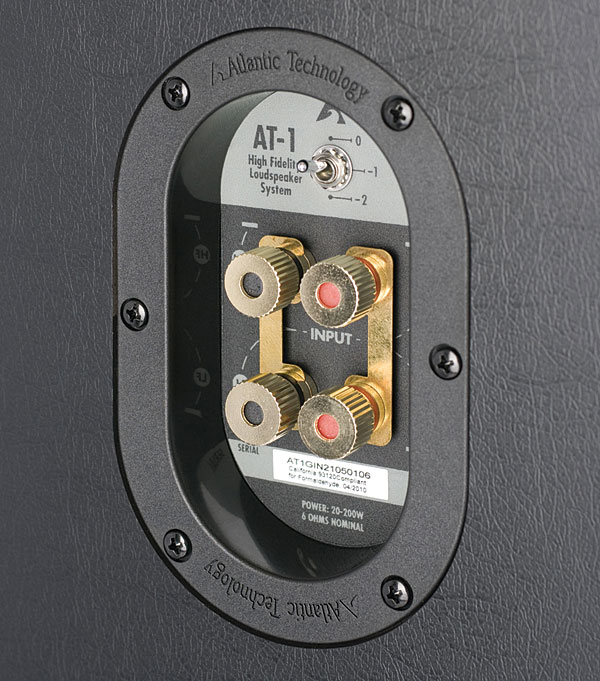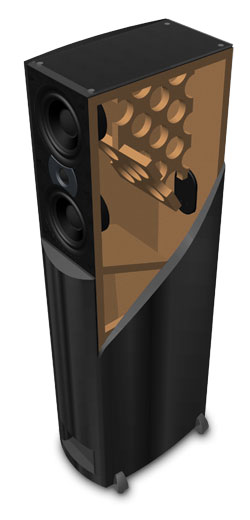| Columns Retired Columns & Blogs |
The above speaker is a decent performer - for a bass reflex. However, there is nothing unique, patent worthy, or even new about the design. PMC has been using resonance traps in its speakers for years.The "patent" shows a tapered transmission line shape with an anti resonance trap whose opening is located at a pinch point within the line. The distortion measurements shown in the patent are as misleading as the marketing hype for this speaker - distortion figures are presented only for select frequencies to make it look better on paper than it really is. In fact, the impedance plot shows the telltale sign of an anti resonance trap - a impedance peak around 100hz. This is actually not a good thing. If you were to measure THD at that frequency, you'd find a noticeable increase. "Anti resonance traps" or acoustic filters have been around since the beginning of transmission lines. Their use actually demonstrates a lack of knowledge/skill in design - not an advancement.
Moreover, the claims of mixing bass reflex with transmission line are totally bogus. True transmission lines possess a gradual 12db per octave rolloff in the bass region below the transducer's Fs or fundamental resonant frequency. This speaker clearly does not. It's rolloff is representative of a reflex design (steeper 24 db/octave roll off below transducer resonance). Compare the low frequency response of this to that of the Vivid Giya "quasi" transmission lines:
http://www.stereophile.com/content/vivid-audio-g1giya-loudspeaker-measurements
What this AT speaker is is a bass reflex with a small horn attached to the port opening and an acoustical filter incorporated to help dampen the upper resonances of a primitive design. Phil is just warming over a 25 year old transmission line patent with the application of an internal restrictor.
Despite the false claims of this speaker's "designers", there is no continuum between a true transmission line and a pseudo "mass loaded transmission line". Mass loading means bass reflex - PERIOD. The velocity of low pressure pulses escaping a transmission line should be in the neighborhood of 340 m/s. The velocity of air transfer in most reflex designs is about 18- 20 meters per second (notice I said "air transfer" - not low pressure acoustical pulses - big, big difference). The mechanical tuning of a reflex design is centered about a Helmholtz resonance - a slug of air being forced through a restrictive pipe. The time it takes to ram the air slug through the restrictor determines the tuning frequency. With a transmission line, there is not supposed to be any "restriction" beyond the slight tapering of the cavity behind the speaker diaphragm that follows the natural reduction in acoustic pressure that occurs when sound radiates a given distance from its source (the 1/distance attenuation rule). The timing (frequency tuning) of a transmission line is established by distance from the source and the frequency whose peak presssure occurs at that distance. Contrary to now unfortunately common assertions, the two approaches can't be mixed. You either have restrictive timing and the inherent 24 db/octave rolloff or you don't.The design concepts are worlds apart and so are the results - particularly when you attempt to feed both designs with sub bass programme material at high volume. The reflex design unloads (over excursion) below tuning frequency and the transmission line just keeps humming along. The frequency response and impedance plots always give them away.

 I settled on listening to the AT-1s with their tweeters at the "–" setting, which alleviated some of the hardness and blended better with the midrange, but gave up more top-octave air. When I pushed the AT-1s to higher volumes, that tendency for hardness in the lower treble also flattened out the soundstage in this region, even with such good recordings as Pantha du Prince's This Bliss (CD, Dial CD09), lessening the wonderful illusion of space this recording can otherwise convey. To put this all in perspective: The AT-1's treble is not at all bad, especially at the price, but the rest of the speaker's performance is so good that this was the single area in which I found the Atlantic's performance slightly lacking.
I settled on listening to the AT-1s with their tweeters at the "–" setting, which alleviated some of the hardness and blended better with the midrange, but gave up more top-octave air. When I pushed the AT-1s to higher volumes, that tendency for hardness in the lower treble also flattened out the soundstage in this region, even with such good recordings as Pantha du Prince's This Bliss (CD, Dial CD09), lessening the wonderful illusion of space this recording can otherwise convey. To put this all in perspective: The AT-1's treble is not at all bad, especially at the price, but the rest of the speaker's performance is so good that this was the single area in which I found the Atlantic's performance slightly lacking.






































